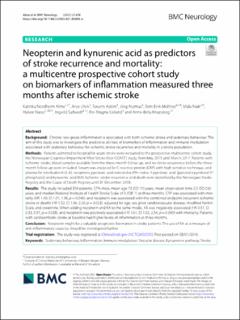| dc.description.abstract | Background Chronic low-grade inflammation is associated with both ischemic stroke and sedentary behaviour. The aim of this study was to investigate the predictive abilities of biomarkers of inflammation and immune modulation associated with sedentary behaviour for ischemic stroke recurrence and mortality in a stroke population. Methods Patients admitted to hospital for acute stroke were recruited to the prospective multicentre cohort study, the Norwegian Cognitive Impairment After Stroke (Nor-COAST) study, from May 2015 until March 2017. Patients with ischemic stroke, blood samples available from the three-month follow-up, and no stroke recurrence before the three-month follow-up were included. Serum was analysed for C-reactive protein (CRP) with high-sensitive technique, and plasma for interleukin-6 (IL-6), neopterin, pyridoxic acid ratio index (PAr-index: 4-pyridoxic acid: [pyrioxal+pyridoxal-5′-phosphate]) and kynurenic acid (KA). Ischemic stroke recurrence and death were identified by the Norwegian Stroke Registry and the Cause of Death Registry until 31 December 2018. Results The study included 354 patients, 57% male, mean age 73 (SD 11) years, mean observation time 2.5 (SD 0.6) years, and median National Institute of Health Stroke Scale of 0 (IQR 1) at three months. CRP was associated with mortality (HR 1.40, CI 1.01, 1.96, p = 0.046), and neopterin was associated with the combined endpoint (recurrent ischemic stroke or death) (HR 1.52, CI 1.06, 2.20, p = 0.023), adjusted for age, sex, prior cerebrovascular disease, modified Rankin Scale, and creatinine. When adding neopterin and KA to the same model, KA was negatively associated (HR 0.57, CI 0.33, 0.97, p = 0.038), and neopterin was positively associated (HR 1.61, CI 1.02, 2.54, p = 0.040) with mortality. Patients with cardioembolic stroke at baseline had higher levels of inflammation at three months. Conclusion Neopterin might be a valuable prognostic biomarker in stroke patients. The use of KA as a measure of anti-inflammatory capacity should be investigated further. | en_US |

